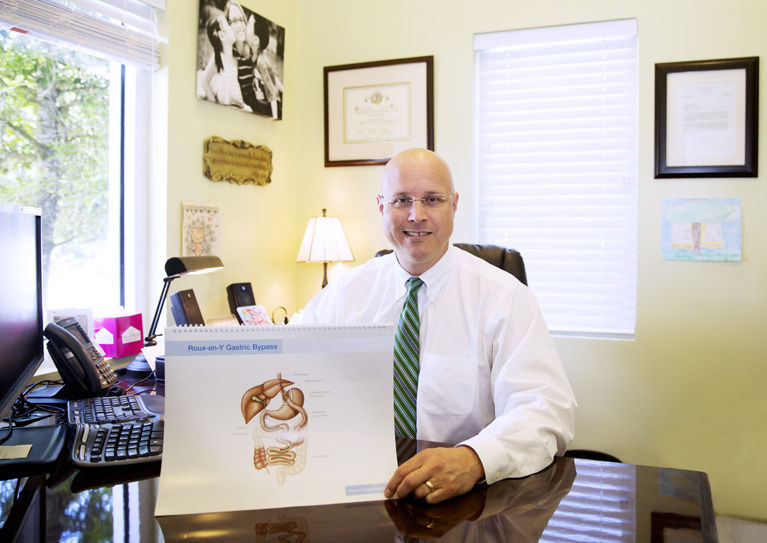
This is not a “Do these pants make me look fat?” weight-loss story. This is about the advanced and extreme surgical procedures that Dr. Patrick Domkowski and Dr. Jason Radecke and their team at the Riverside Surgical and Weight Loss Center and the Sebastian River Medical Center are undertaking every day to save the lives of people who are morbidly obese.
Morbid obesity is generally defined as being 80 to 100 pounds or more overweight and having a body mass index (BMI) over 35 while also experiencing serious health conditions such as high blood pressure, diabetes, sleep apnea and other related problems.
(Body mass index or BMI is height-to-weight ratio. It is calculated by dividing a person’s weight in kilograms by the square of that person’s height in meters.)
Despite what many believe, obesity is not simply due to a lack of willpower. Research shows that genetic pre-disposition is a far more likely cause.
Domkowski, a graduate of Georgetown University medical school whose internship, fellowship and residency were served at Duke University, is quick to point out weight-loss surgery is far more complicated than many people realize. Patients don’t just walk in one day and walk out the next many pounds lighter. Neither, he says, should it ever be confused with cosmetic surgery. His patients aren’t movie starlets looking for tummy-tucks.
Most of his patients, Domkowski explains, come in with a weight close to or above 300 pounds. A huge percentage have become insulin-dependent due to diabetes.
They often bring tearful tales through the door with them. One that sticks in Domkowski’s mind is the distraught grandmother who told him, “I can’t take the grandkids to Disney. I’m too heavy for the rides.”
Whatever else weight-loss surgery is, however, it is not a quick fix.
For starters, there is an extensive screening process including medical exams, a psychologist’s examination, seminars, classes, videos and working with a nutritionist before surgery is ever undertaken. Many bariatric surgeons even insist their patients lose up to 15 pounds on their own as a sign of commitment. All that, according to Domkowski, can take up to six months before a surgery is scheduled.
In Domkowski’s close to 12 years of practice here he estimates as many as eight out of 10 of his patients are women. Nationally, the Cleveland Clinic estimates morbid obesity affects 4.4 percent of the country’s male population and 8.2 percent of women.
While there are a number of bariatric weight-loss surgical procedures, Domkowski appears to favor three in particular: the gastric bypass or Roux-en-Y bypass, the sleeve gastrectomy and the biliopancreatic diversion with duodenal switch gastric bypass.
In a gastric bypass, a small stomach pouch is created by dividing the top of the stomach from the bottom. In the very simplest of terms, that newly created pouch is considerably smaller and accommodates significantly less food than before. Patients feel fuller and consume fewer calories.
For a sleeve gastrectomy, the University of Maryland Medical Center in Baltimore says approximately 85 percent of the stomach is removed entirely. The remaining 15 percent holds much less food than the normal stomach which, again, radically restricts calorie intake. The greater impact, however, may be the effect the surgery has on certain hormones that regulate hunger and blood sugar control. Less food feels like more.
The biliopancreatic diversion with duodenal switch procedure is more complex. First, a small tubular stomach pouch is created by removing a portion of the stomach, very similar to the sleeve gastrectomy and then a large portion of the small intestine is bypassed. In fact, roughly three-fourths of the small intestine is bypassed. This results in another significant decrease in the absorption of calories, nutrients and fat.
One other fairly common form of bariatric surgery you won’t see Domkowski performing is known as “lap band” or “gastric banding.”
According to Domkowski, “It doesn’t work. I’ve done them,” he continues, “but I wasn’t happy with the results and my patients weren’t happy. As a long term solution, it just doesn’t work.”
The procedure is widely used and seems simple enough: It involves wrapping an adjustable band around the stomach to restrict food intake. But clearly Domkowski is not a fan.
What Domkowski is a fan of – in addition to the 2015 national championship Duke basketball team – is the results his surgeries have on his patients’ lives. His gastric bypass operations, he states proudly, average about 120 pounds of weight loss per patient. In another, even more dramatic claim, Domkowski says, “If we do a gastric bypass on someone who’s insulin-dependent, they’re going to leave the hospital completely off insulin. The result is that immediate metabolically.”
He says the average hospital stay, “is only two-to-three days and patients can resume their normal lives (with dietary restrictions) in just two to three weeks.”
These procedures, explains Domkowski, are done “laparoscopically,” meaning several small or “minimally invasive” incisions are made in the abdomen. Tubes with miniaturized surgical tools are inserted to make the necessary cuts and even to sew and seal the tissue closed again.
Domkowski says the average patient will lose 10 to 12 pounds per month for 18 months after surgery and the long-term success rate (keeping the lost weight off) on a gastric bypass is near 80 percent.
That, says Domkowski, “really is life-saving surgery.”
Dr. Patrick Domkowski is at Riverside Surgical & Weight Loss Center and the Sebastian River Medical Center. His office phone number is 772-581-8003.



